
Spoiler Alert
Who doesn’t love Catwoman? She’s smart, sassy, independent, has her own moral code, and often outfoxes (or maybe outcats) Batman, one of the greatest superheroes of all time. Though I’d be hard-pressed to label her skin-tight, uber-revealing outfit as feminist, Catwoman is a famous sex symbol who uses her sexuality to her own advantage. The figure of Catwoman has gone through dozens of iterations over the years, which goes to show that this iconic figure is a potent anti-heroine or villainess who continues to appeal to audiences throughout the generations. I’ve done a bit of meditating on these incarnations and questioned which of them is the most feminist representation.
Illustrated
First, we’ve got her comic book origin as The Cat in 1940’s Batman #1.

That’s right. Catwoman was birthed alongside the legend of Batman himself. Unfortunately, her creator Bob Kane was a misogynist and sought to portray traits that he coded as feminine:
“I felt that women were more feline creatures and…cats are cool, detached, and unreliable…You always need to keep women at arm’s length. We don’t want anyone taking over our souls, and women have a habit of doing that. So there’s a love-resentment thing with women. I guess women will feel that I’m being chauvinistic to speak this way…”
All I have to say is, “You’re right, Bob: you are a chauvenist,” and, “ew.” That said, Catwoman was designed as an unattainable love interest that personified the aloof and perhaps vindictive qualities her creators saw within female sexuality. Her depiction is more about drumming up some sexual interest and excitement for Batman than creating a nuanced character.

Though I’m a bit of a comic book nerd who’s absolutely drawn to strong female characters, I’ve never been interested in reading any graphic novel Catwoman series. Her later depictions always struck me as a lot of tits and ass without substance, which I’m primarily basing on the cover art. Her sexuality is showcased to the extreme where it’s hard to imagine anything else beneath it. (If you’re a reader of Catwoman comics and feel differently, please set me straight in the comments!)

I am, however, intrigued by her more recent, vicious comic book portrayals. Those have grit and make me curious about her.

There are also multiple cartoon renderings of Catwoman that are more or less underwhelming. In Batman: The Animated Series, Catwoman does get to have layers in that she’s a jewel thief, an animal rights activist, and has her alter-ego as Selina Kyle, but her main role continues to be an elusive love interest for Batman as opposed to a compelling character.
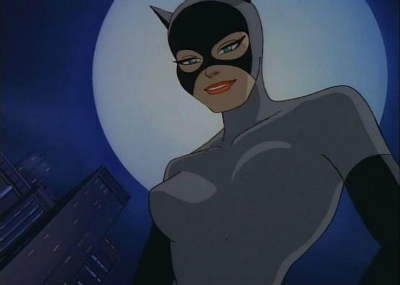
Television
Catwoman made her television debut on the Batman series in 1966. Julie Newmar performed perhaps the most memorable version of Catwoman. I was certainly smitten with her. She was lovely, imposing, and “diabolical” (as Batman would say). She was a lone woman who commanded a group of male thugs. Among the great supervillains of the TV Batman mythology, she was the only woman, and she certainly held her own.
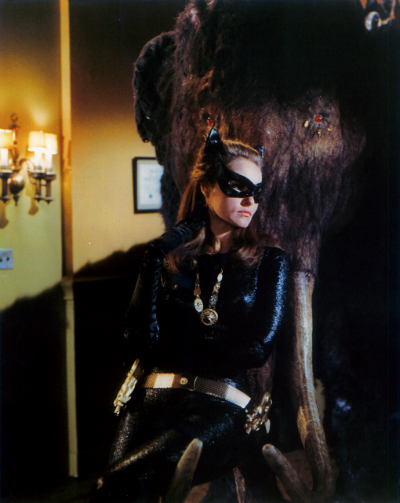
Lee Meriwether was chosen for the film version of the Batman TV show. She, too, was stunning and very similar in appearance to Julie Newmar. Meriwether’s Catwoman also had a faux-alter ego as Miss Kitka, Russian journalist designed to seduce and lure “Comrade Wayne” into supervillain coalition custody to elicit Batman’s rescue attempts. This may have been the first sustained disguise Catwoman ever put on. She was never Selina Kyle in the TV show, which left her somewhat one-dimensional, but none of the other supervillains really had alter egos either.

The last Batman TV show Catwoman is the late, great Eartha Kitt. A magnetic personality who brought more flare to the role than any before, Kitt was the first Black woman to play Catwoman…and, I believe, the first Black woman to prominently feature on the show. Race and inclusivity were and continue to be issues that most media fail to properly address. Eartha Kitt’s Catwoman was much like Nichelle Nichols‘ Uhura on Star Trek: a pioneer, a weather vane showing that times were changing, and a kickass character to boot. If it had been gratifying in Season 1 & 2 to see a solitary woman ordering around a gang of male minions, then it was even more so in Season 3 to see a Black woman calling the shots.

Film
We got to see another talented Black woman, Halle Berry, reprise the role in 2004’s Catwoman. Unfortunately, the flick was universally considered a turd that was really a vehicle to showcase/exploit an Academy Award winning actress’s body with the most revealing catsuit of all time (and that’s saying something). I could really push the envelope to suggest a feminist reading of the film’s beauty industry critique, as Berry’s Patience Phillips struggles to destroy the anti-aging cosmetic corporation that employs her because it is selling a faulty and harmful product, but the fact that her boss (the one who kills her thus turning her into Catwoman) is a woman (Sharon Stone, no less) takes a lot of the steam out of that argument.
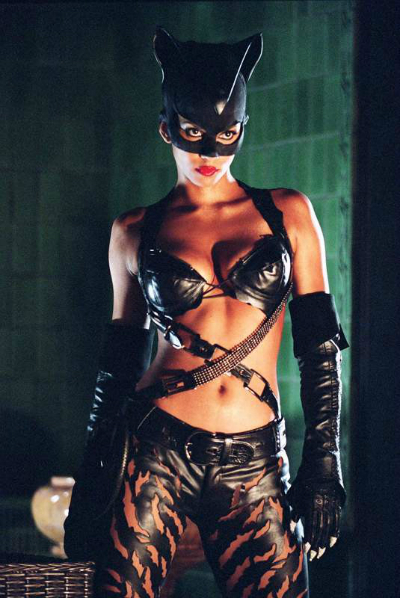
We also have the most recent depiction of Catwoman in Christopher Nolan‘s third installment of his Batman trilogy: The Dark Knight Rises in 2012. Though I’ve never been a fan of Anne Hathaway, I was nonetheless generally impressed with her Catwoman performance. Hathaway’s Selina Kyle was strong, independent, clever, and had a righteous sense of class justice, and in spite of the catsuit, she wasn’t quite as sexualized as earlier film incarnations.

That said, Hathaway technically isn’t Catwoman. She doesn’t give herself that name nor is she dubbed with it by an opponent or ally. Contrary to the opinion of fellow reviewer Kelsea Stahler, I think taking the title away from her divests her of some of the power, prestige, and legacy that is inherent in her name. Though I did admire Anne Hathaway’s smart-and-ruthless-with-a-smattering-of-conscience characterization, this version of Catwoman ultimately fails my feminist expectations because she ends up with Bruce Wayne in the end. She runs away to France and allows him to domesticate her. Stripping Catwoman of her counter-culture independence and settling her down with a man is tantamount to de-clawing her.
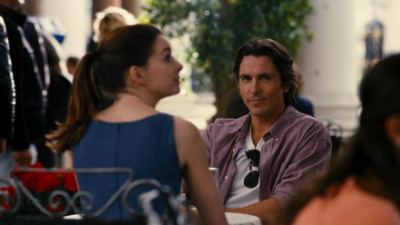
No, in this reviewer’s humble-ish opinion, the most feminist depiction of Catwoman is Michelle Pfeiffer from Tim Burton’s 1992 Batman Returns. Though this Catwoman is oozing sex, she always has her own agenda and is crafty enough to DIY-style make her own iconic cat costume. Pfeiffer’s Selina Kyle is mentally unstable and has periodic breaks with reality, which is a realistic rendering of a woman suffering post-traumatic stress disorder (PTSD) after being attacked and murdered by her boss.
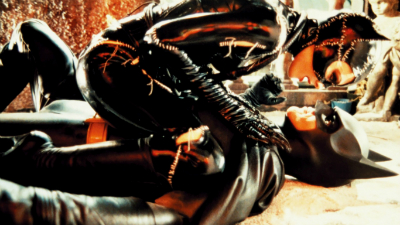
The end of Batman Returns has Batman stripping off his mask and asking Catwoman not to kill her boss, but to leave town and come away with him instead. This is the inverse of what happens in The Dark Knight Rises as Hathaway’s Kyle begs Batman to abandon Gotham and run away with her. Pfeiffer’s response as Catwoman is, “Bruce, I would love to live with you in your castle forever just like in a fairy tale. I just couldn’t live with myself, so don’t pretend this is a happy ending!” She then claws Batman’s face and kills her boss, using up all but one of her nine lives to do so. Now, I’m not all about killing or anything, but the point is that Selina Kyle rejects Batman’s idea of who she should be, what her moral code should be, and how she should heal. She acknowledges the appeal of the traditional “fairy tale” conclusion that ends her story with a man and love, but her need for independence and for self-actualization becomes too important for her to sacrifice by relying on romantic love to save her as she once would have before her transformation into Catwoman. Instead, her story continues on, and we can imagine all the possible paths she may have chosen for her life.
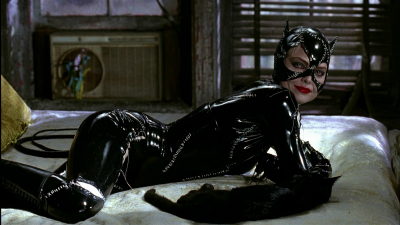
All the Catwomen are hyper-sexualized and mysterious. All of them wield power over Batman and Gotham’s underworld. Though Pfeiffer’s Catwoman is my pick as the most feminist of all the iterations I’ve seen, she’s still problematic as are all her Cat sisters. I see the feminist strength and independence in her, but I also see the way sex is her weapon and that she mostly exists as a foil for Batman, a temptation and a lesson on what rampant desires can lead to. Maybe I’m more like Batman than I’d care to admit in that I, too, recognize the appeal of Catwoman as a mixed bag, and I, too, am drawn to her against my better judgement.
——————
Amanda Rodriguez is an environmental activist living in Asheville, North Carolina. She holds a BA from Antioch College in Yellow Springs, Ohio and an MFA in fiction writing from Queens University in Charlotte, NC. She writes all about food and drinking games on her blog Booze and Baking. Fun fact: while living in Kyoto, Japan, her house was attacked by monkeys.
I’m so pleased to see an honest and insightful critique of the many iterations of Catwoman. Growing up, I remember watching her and she was always a favorite of mine, for many of the reasons you discuss here – strong, independent, powerful, leader of men (in the 60s live action versions), sexually liberated (though at times exaggeratedly so, but at age 13 I didn’t understand that), and a non-conformist. Now that I’m “all grown up”, I’ve also struggled with her being a “mixed bag”. So much I love, but many of her faces also include her being depicted as a hypersexualized and objectified character, frequently illustrated in comics with the sole purpose of drawing the male gaze.
However, I’ve reached a point where I have decided not to let these misogynistic representations ruin her for me. I’ve decided that they don’t deserve to rob me of a beloved character whose many strengths certainly benefited and shaped who I am today. So I’ll take that mixed bag
I’m so glad my views resonated with you, @disqus_UJqyqOqWZD:disqus! Though Catwoman is an especially mixed bag, it seems like most female representations are these days, and you’re right, we have to find inspiration in the worthy parts and loudly critique the rest!
Re: Comics. The recent Brubaker/Cooke run of Catwoman was. Awesome. She was sexy without being sexualized (as far as I remember…). She was the main character and her actions drove the story. The stories were also usually pretty interesting, especially the earlier stuff. The New 52 title is everything the Brubaker/Cooke run wasn’t.
Thanks for the insight! I read the original 52 series (mainly for the intro to Batwoman), and it was a bit lackluster and definitely didn’t have Catwoman in it. I’ll have to check out the new one!